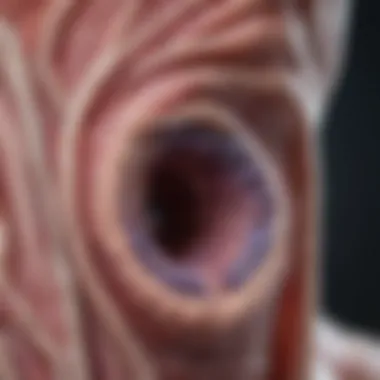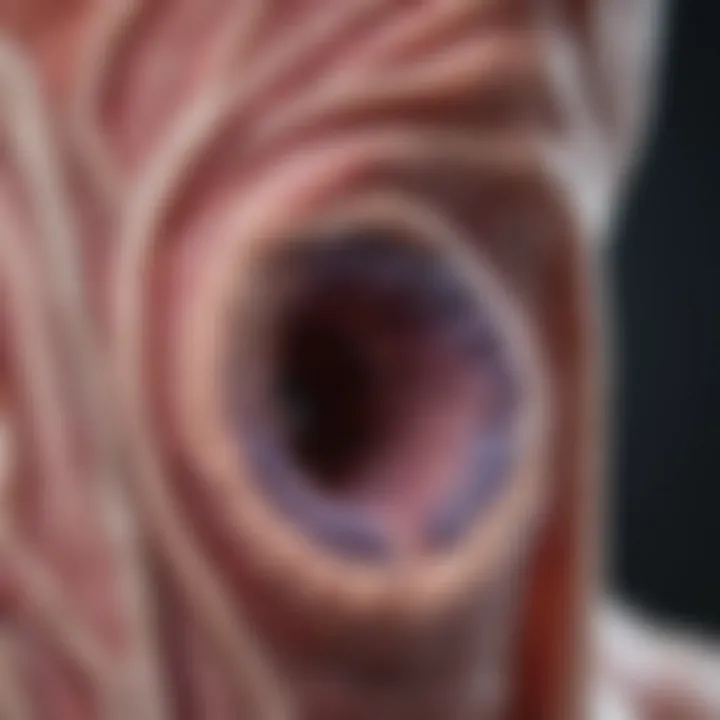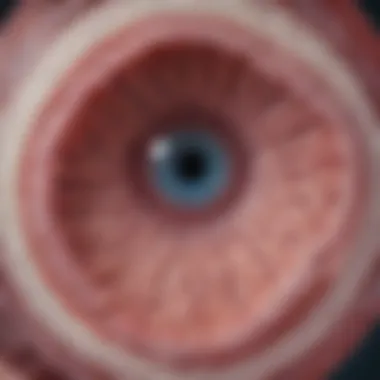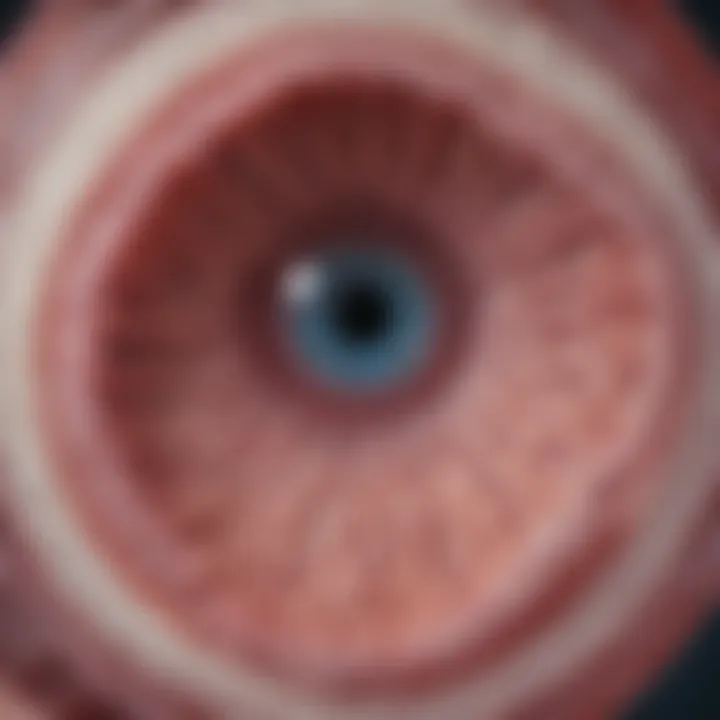Esophageal Rings and Eosinophilic Esophagitis Explained


Intro
Esophageal rings, particularly in relation to eosinophilic esophagitis (EoE), represent a fascinating yet complex intersection of anatomy and pathology. While many might not grasp the significance of these rings initially, their association with various esophageal disorders sheds light on potential treatment paths. EoE is an allergic inflammatory condition characterized by an abnormal accumulation of eosinophils in the esophagus, leading to symptoms that can markedly erode the quality of life. This comprehensive exploration aims to provide valuable insights into the underlying mechanisms and clinical implications of esophageal rings, thereby enriching the understanding of both patients and healthcare providers.
As we dissect the relationship between these entities, we must consider current diagnostic criteria and innovative treatment approaches. Grasping the physiological architecture of the esophagus and recognizing the red flags in observation can guide effective management strategies. What’s more, understanding emerging research can illuminate future directions for better therapeutic results. Those delving into this niche area of gastroenterology will find a wealth of information that could shape their approach to diagnosis and treatment.
Research Overview
Understanding the dynamics between esophageal rings and eosinophilic esophagitis is vital. Several methodological approaches come into play to enhance our comprehension of this interaction. Firstly, clinical observations combined with detailed patient histories often reveal patterns that prompt further investigation. Secondly, endoscopic evaluations have become pivotal in identifying these rings and confirming eosinophilic infiltration in tissue samples. The combination of these approaches helps to construct a clearer picture of esophageal conditions, guiding one's clinical approach.
One can dive into studies utilizing imaging technology, which aids in the visualization of the esophagus's structural anomalies. Additionally, collaboration between gastroenterologists and allergists is proving beneficial. This interdisciplinary connection not only enhances the understanding of the mechanisms involved but also fosters a more holistic approach to treatment.
Methodological Approaches
- Clinical history review
- Endoscopic evaluations
- Imaging technology
- Merging insights from gastroenterologists and allergists
Significance and Implications
Understanding esophageal rings in the context of EoE holds substantial significance for clinical practice. These rings can indicate the severity of the condition and its response to treatment strategies. The presence of rings may escalate the need for more assertive therapeutic interventions, including dietary modifications or medications. Moreover, finding effective management for patients helps prevent long-term complications, which resonates with the core objective of medical practice: improving patient outcomes.
Current Trends in Science
The landscape of gastroenterology continues to evolve as current trends emerge, revealing innovative techniques and tools that aid in understanding esophageal abnormalities. Precision medicine is gaining traction in the treatment of eosinophilic esophagitis. This approach not only helps in tailoring medication to individual patients based on their specific immunological profiles but also enhances the ability to anticipate treatment responses.
Innovative Techniques and Tools
- Use of pH monitoring alongside endoscopy
- Application of genetic testing to guide treatment
- Development of targeted biologic therapies
Interdisciplinary Connections
The connection between gastroenterology, immunology, and allergology presents a promising horizon in treating eosinophilic esophagitis. Researchers are increasingly examining the implications of food allergies and environmental factors, linking them with the incidence of EoE. As knowledge expands, so too do possibilities for future collaborations across disciplines.
"A comprehensive understanding of esophageal rings could not only enhance diagnostic acumen but dramatically shift patient management strategies."
By blending traditional methods with cutting-edge research and interdisciplinary collaboration, we are edging closer to achieving better outcomes for patients navigating the complexities of eosinophilic esophagitis. Understanding these relationships not only captures the intricacies of the disease but solidifies its importance in contemporary gastroenterological discourse.
Foreword
The exploration of esophageal rings and their connection to eosinophilic esophagitis is a vital aspect of understanding esophageal health. The esophagus, as one of the key players in the digestive system, is susceptible to various anomalies which can influence overall well-being. In this article, we aim to dissect this intricate relationship, focusing not only on the clinical manifestations but also on underlying physiological and pathological processes.
Eosinophilic esophagitis, commonly regarded as EoE, is characterized by inflammation caused by an excessive number of eosinophils in the esophageal lining. It often leads to difficulty in swallowing, food impaction, and persistent heartburn-like symptoms. The appearance of esophageal rings, which can be defined as circumferential constrictions within the esophagus, typically generates concern among medical practitioners and patients alike. Because these rings can lead to dysphagia or difficulty in swallowing, they warrant thorough investigation.
Understanding the nuances of esophageal rings lays the groundwork for better diagnostics and management strategies for eosinophilic esophagitis. Awareness of how these structures manifest either as concentric or eccentric shapes informs not only clinical decision-making but also how patient symptoms are interpreted. For instance, a concentric ring might indicate a more uniform narrowing, while an eccentric ring could suggest localized pathology, potentially complicating the treatment approach.
Furthermore, our discussion incorporates current research trends, shedding light on how ongoing studies influence clinical practice. This holistic view serves not just to educate professionals in the field but also provides valuable insights for students and researchers who wish to delve deeper into gastroenterological health.
Ultimately, this article aims to elucidate the complex dynamics between esophageal rings and eosinophilic esophagitis. By revealing the connections between anatomy, pathophysiology, and clinical ramifications, we hope to offer an informative resource that emphasizes the importance of this relationship in the broader context of gastroenterology.
Anatomy of the Esophagus
The esophagus, a muscular tube extending from the throat to the stomach, plays a crucial role in the digestive process. It’s vital to understand its anatomy in the context of esophageal rings and eosinophilic esophagitis, as these conditions directly affect how the esophagus functions. This section provides insights into the structural components and functional roles of the esophagus, forming a foundation for further investigation into its ailments.
Structural Overview
The esophagus is roughly 25 centimeters long in adults and has a layered structure consisting of:
- Mucosa: The innermost layer, lined with epithelial cells that gather mucus, making swallowing smoother. This layer often becomes inflamed in cases of eosinophilic esophagitis, leading to visible changes in its integrity.
- Muscularis: This middle layer comprises both circular and longitudinal muscle fibers. The coordinated contraction of these muscles propels food down towards the stomach, highlighting the esophagus's essential role in peristalsis.
- Adventitia: The outermost layer, offering structural support and anchoring the esophagus in surrounding tissues.
Understanding these components helps to visualize how conditions like esophageal rings can form and obstruct this passage, contributing to dysphagia and other symptoms.
Esophageal Functionality
The functionality of the esophagus is multifaceted, intertwining structural properties with physiological processes. Here are key points to consider:
- Swallowing Mechanism: The esophagus facilitates the transport of food boluses initiated by swallowing. Proper function depends on the integrity of its structure, as any abnormalities can lead to complications.
- Lower Esophageal Sphincter (LES): At the juncture of the esophagus and stomach, the LES acts as a valve regulating the flow of food and preventing backflow. Difficulties here can lead to gastroesophageal reflux disease (GERD), exacerbating esophageal discomfort.
- Receptive Relaxation: This phenomenon enables the esophagus to expand when swallowing larger pieces of food. Conditions affecting the esophagus can impair this ability, resulting in discomfort or pain.
"Understanding esophageal functionality is critical, as it lays the groundwork for discerning how conditions like eosinophilic esophagitis and esophageal rings manifest clinically."
Esophageal Rings: Definition and Characteristics


Esophageal rings, while often overlooked in discussions of esophageal disorders, bear a significant relevance in relation to eosinophilic esophagitis (EoE). These rings can be anatomical variations in the esophagus that lead to various complications, especially in patients suffering from EoE. Understanding these rings helps identify potential treatment avenues and management strategies. Not only do these rings affect the esophagus's ability to function properly, but they can also exacerbate symptoms in an individual with EoE.
By exploring esophageal rings—specifically their types, symptoms, and clinical presentation—we can shed light on their clinical significance and contribution to patient care.
Types of Esophageal Rings
Concentric Rings
When discussing concentric rings, we refer to circular structures that maintain a uniform diameter. These rings are situated equidistantly from the esophageal lumen’s center. A key characteristic of concentric rings is their consistency in shape, which often leads to the achievement of a uniform profile in the esophagus. This characteristic makes them a focal point in diagnosing structural abnormalities that arise in patients with EoE.
Among the advantages of concentric rings, we find their ability to create a smooth transition when swallowing. However, they can also pose challenges, as their presence may lead to blockages in more severe cases. In this article, their relevance extends to understanding how they can interact with eosinophilic infiltration, ultimately influencing treatment protocols.
Eccentric Rings
Eccentric rings differ from their concentric counterparts in a prominent way: they are not uniformly shaped, and their diameter varies around the esophageal lumen. This unique feature presents a distinct challenge when considering esophageal health. Typically, these rings might develop due to scar tissue formation, possibly as a result of chronic inflammation from EoE.
A pivotal factor regarding eccentric rings is how they can narrow pathways in the esophagus, creating difficulty during the swallowing process. Their irregularity can also complicate diagnostic procedures, as varied shapes may hinder visualization during endoscopies. While these rings highlight the importance of accurate diagnosis and assessment in patients, they also signify the need for targeted treatments to alleviate the symptoms and improve overall quality of life.
Symptoms and Clinical Presentation
The clinical presentation of esophageal rings varies widely. Common symptoms include:
- Difficulty swallowing
- Food impaction
- Chest pain
- Heartburn or dysphagia
Patients may also report sensation of a lump in the throat, a distressing situation that becomes especially prominent when esophageal rings are present. In addressing these symptoms, it’s crucial to evaluate not just the rings themselves but also their relationship to eosinophilic esophagitis.
In summary, understanding esophageal rings and their characteristics— along with their connection to eosinophilic esophagitis—provides a comprehensive insight into this intricate topic. It serves to enhance our understanding of esophageal health while guiding further investigation into effective management strategies.
Eosinophilic Esophagitis: Pathophysiology
The pathophysiology of eosinophilic esophagitis (EoE) is a cornerstone aspect of understanding this increasingly prevalent condition. This section outlines how the condition manifests on both macroscopic and microscopic levels, shedding light on its implications for treatment and diagnosis.
Immune-Mediated Mechanisms
Eosinophilic esophagitis is fundamentally an immune-mediated disease. To simplify the concept, imagine the esophagus as a battlefield where the body’s immune system misidentifies food proteins and environmental allergens as foes. This miscalculation leads to an inflammatory response characterized primarily by a buildup of eosinophils, a type of white blood cell. The role of these cells is crucial; they are released in response to allergens and contribute to the inflammation process, ultimately leading to esophageal dysfunction.
In terms of biological interactions, the signaling pathways activated in EoE imply a complex response involving several cytokines, especially interleukin-5. This cytokine is critical for eosinophil survival and recruitment, highlighting its role as a key player in the inflammatory mechanism.
Additionally, genetic predisposition can significantly influence how an individual's immune system reacts to allergens. There's evidence suggesting that polymorphisms in certain genes affect the likelihood of developing EoE, which signals a need for further exploration in genetics to tailor more effective treatment strategies.
Role of Eosinophils
Eosinophils are not just bystanders in the pathology of EoE; they are both the main players and the messengers. Once they accumulate in the esophagus, they release a variety of mediators that can cause tissue damage and esophageal remodeling. This remodeling often leads to complications such as esophageal rings and strictures, conditions that can severely impact patient quality of life.
The inflammatory response often results in the following features in affected individuals:
- Dysphagia: Difficulty in swallowing caused by food obstruction.
- Chest Pain: Often mistaken for cardiac issues, exacerbated by esophageal contraction abnormalities.
- Heartburn: While not uncommon in many, it tends to be persistent and unresponsive to traditional treatments in EoE cases.
Interestingly, the presence of eosinophils in the esophagus has been shown to correlate with clinical severity. A higher eosinophil count often means worse symptoms and a greater likelihood for complications. This underscores the importance of monitoring these cells during diagnosis and treatment, as it provides a window into how aggressively the condition may be affecting a patient.
Eosinophilic esophagitis is often likened to a door that slowly shuts on a person, making the act of swallowing progressively more laborious.
In summary, the pathophysiology of eosinophilic esophagitis involves intricate immune-mediated mechanisms and the pivotal role of eosinophils, setting the stage for both clinical symptomatology and potential treatment pathways. A nuanced understanding not only illuminates the challenges faced by individuals with EoE but also guides researchers and healthcare professionals toward more effective interventions.
Diagnosis of Eosinophilic Esophagitis
Diagnosing eosinophilic esophagitis is crucial for effective management and treatment. This condition often goes undetected for years, leading to prolonged discomfort or complications. A thorough understanding of the diagnostic process is necessary to address underlying issues related to esophageal rings.
Clinical Evaluation
Clinical evaluation serves as the initial step in diagnosing eosinophilic esophagitis. Physicians delve into a comprehensive patient history, assessing symptoms like dysphagia, food impaction, or chest pain. This evaluation is not just about gathering information; it’s a crucial moment to connect the dots between symptoms and potential underlying conditions.
In many instances, patients might not be able to pinpoint their discomfort clearly. They may report vague symptoms, which makes it imperative for the clinician to ask targeted questions. Important considerations during this stage also include determining whether there is a history of allergies, which can play a pivotal role in eosinophilic esophagitis.
- Immune Responses: Patients often have a history of other allergic conditions like asthma or atopic dermatitis, hinting at an immune-mediated response.
- Symptom Patterns: Timing and triggers for symptoms may shed light on the condition's potential relation to food intake or environmental allergens.
Overall, a detailed clinical evaluation lays the groundwork for further testing and management strategies for eosinophilic esophagitis, ensuring that appropriate next steps are identified.
Endoscopic Findings


When clinical evaluation raises suspicion for eosinophilic esophagitis, endoscopic investigation becomes critical. Endoscopy can reveal distinct visual patterns that help distinguish eosinophilic esophagitis from other esophageal disorders, including the identification of esophageal rings, which may present as concentric or eccentric narrowing.
Biopsy Techniques
Biopsy techniques are integral to the diagnostic process. During an endoscopy, the physician can collect samples of the esophageal lining, allowing for histological examination. The primary goal here is to count the eosinophils present in tissue sections.
- Key Characteristic: The hallmark of eosinophilic esophagitis is an eosinophil count greater than 15 per high-power field, which is a significant indicator of active disease.
- Popular Approach: Performing multiple biopsies from different esophageal regions improves the chance of capturing significant findings and confirming diagnosis.
- Advantages: This method provides a clear picture, enabling clinicians to not only confirm eosinophilic esophagitis but also to rule out other pathologies that might mimic similar symptoms.
However, it's crucial to note potential disadvantages such as the risk of complications from the procedure, and some patients may have difficulty tolerating the procedure.
Visual Indicators
The endoscope can also reveal various visual indicators that are characteristic of eosinophilic esophagitis. Findings might include rings, white specks, or strictures.
- Key Characteristic: The presence of concentric rings, known as "feline esophagus," can be particularly telling and direct attention toward eosinophilic esophagitis specifically. This finding sets it apart from other esophageal disorders.
- Benefits: Visual indicators help in understanding the severity of the condition and in planning any necessary interventions.
- Unique Feature: The endoscopic appearance can vary between patients, making it both a challenging and intriguing aspect of diagnosis. Each patient's presentation can provide unique insights into their individual condition.
In summary, diagnosing eosinophilic esophagitis requires a confluence of clinical evaluation and detailed endoscopic assessment. Understanding the typical findings and techniques applied during this process ensures timely and appropriate management, bringing into focus the relationship between esophageal rings and eosinophilic esophagitis for effective therapeutic strategies.
Relationship Between Esophageal Rings and Eosinophilic Esophagitis
The connection between esophageal rings and eosinophilic esophagitis (EoE) is a significant topic that sheds light on both anatomical and pathological considerations in gastroenterological health. Understanding how these two phenomena interact provides insights that are essential for accurate diagnosis and effective treatment strategies. When delving into the dynamics of EoE and its relationship with esophageal rings, many key aspects come into play, including the mechanisms that lead to changes in esophageal structure and how these changes affect patient symptoms.
The relationship is particularly evident when considering how esophageal rings can potentially contribute to the symptoms of EoE. Patients suffering from EoE often report difficulty swallowing, food impaction, and chest pain. These symptoms can be exacerbated by the presence of esophageal rings, as they can narrow the esophageal lumen, creating a scenario where food can easily become stuck. Hence, understanding this connection can be instrumental in tailoring treatment plans that effectively address both conditions.
Additionally, clinicians must consider the multifaceted nature of EoE and its triggers, which may also correlate with the presence of esophageal rings. Factors such as dietary habits, allergic responses, and inflammatory processes can all interplay and contribute to the morphology of the esophagus. As a result, a more comprehensive grasp of how these rings manifest in patients with EoE can assist in establishing a more holistic approach to patient care.
"The interplay between esophageal rings and EoE illustrates the complexity of gastrointestinal disorders, emphasizing the need for a detailed understanding of esophageal anatomy and pathology."
Pathological Insights
The pathological relationship between esophageal rings and eosinophilic esophagitis is critical to unraveling the complications associated with both conditions. Esophageal rings, particularly when influenced by prolonged eosinophilic inflammation, can become markedly altered. In EoE, eosinophils infiltrate the esophageal tissue, leading to inflammation and, ultimately, structural changes within the esophagus. This process gives rise to different types of esophageal rings, notably symmetrical concentric and asymmetrical eccentric rings.
Eosinophilic inflammatory processes can stimulate fibrosis and tissue remodeling, culminating in the formation of these rings. When the esophagus undergoes such structural changes, it is not merely a symptom of the underlying disease but also a direct consequence of the chronic condition itself. Such a relationship highlights the need for pathologists and gastroenterologists to consider these rings not just as incidental findings but as integral components of the inflammatory landscape that characterizes EoE.
In research settings, the study of the interactions between these rings and eosinophilic activity has gained attention. Certain studies have noted that monitoring the development of esophageal rings can serve as a potential biomarker for disease progression in patients with EoE, suggesting that early interventions may prevent more severe outcomes.
Clinical Significance
The clinical significance of understanding the relationship between esophageal rings and eosinophilic esophagitis cannot be understated. For healthcare providers, recognizing the potential impact of esophageal rings on symptom severity is crucial. Patients who present with symptoms characteristic of EoE should be thoroughly evaluated, considering the presence of esophageal rings that may complicate the clinical picture.
Effective management of EoE often requires a dual approach that addresses both inflammatory processes and structural abnormalities associated with esophageal rings. This may include dietary interventions, such as an elimination diet, to minimize eosinophilic activation, as well as pharmacological treatments aimed at reducing inflammation. Furthermore, in cases where esophageal rings are particularly pronounced, endoscopic intervention may be necessary to alleviate strictures and improve lumen patency.
Moreover, patients often benefit from patient education that informs them about their condition and the potential complications related to esophageal rings. Understanding this relationship not only equips individuals with knowledge for self-management but also fosters a collaborative dynamic between patients and healthcare providers.
In summary, the intertwining of esophageal rings and eosinophilic esophagitis presents a multifaceted challenge. Addressing this relationship enhances our ability to deliver targeted therapeutics and improve quality of life for affected individuals.
Management Strategies for Eosinophilic Esophagitis
Managing Eosinophilic Esophagitis (EoE) is crucial for ameliorating symptoms and preventing complications such as esophageal rings. This condition often leads to inflammation that contributes to dysphagia and food impaction. Thus, carefully crafted management strategies play a pivotal role in maintaining quality of life for affected individuals. These strategies predominantly encompass dietary modifications and pharmacological treatments. Their importance lies not only in symptomatic relief but also in addressing the underlying etiopathology influencing esophageal changes, including the formation of rings.
Dietary Modifications
Dietary changes are often the first line of defense against EoE, as the condition is frequently triggered by specific food allergens.
A. Elimination Diets: The cornerstone of managing EoE through diet focuses on identifying and avoiding offending foods. Physicians usually recommend elimination diets that help pinpoint specific triggers. Common culprits include milk, eggs, wheat, soy, nuts, and seafood. After a period of elimination, foods can be gradually reintroduced to determine tolerance levels. This method not only aids in symptom reduction but can also contribute to the healing of esophageal tissues. According to some studies, about 75% of patients note significant improvement when following a well-structured elimination diet.
B. Nutritional Support: It is vital to ensure that dietary changes do not lead to nutritional deficiencies. For instance, a person who cuts out entire food groups might miss crucial vitamins and minerals. Consulting with a registered dietitian while implementing dietary modifications can be incredibly beneficial. Some patients may also opt for elemental diets, where their nutrition is supplied through completely hydrolyzed formulas, bypassing potential allergens altogether.
Pharmacological Treatments
Medications can significantly alleviate symptoms and manage inflammation associated with EoE. Common pharmacological strategies encompass both topical steroids and systemic therapies.
Topical Steroids
Topical corticosteroids are designed to target localized inflammation within the esophagus. One key characteristic of these medications is their ability to minimize symptoms without widespread systemic effects. When swallowed as a liquid or aerosolized form, such as Fluticasone or Budesonide, they tend to cling to the esophageal lining, thus providing localized therapy. This feature makes topical steroids a favorable option for many patients.
Advantages of topical steroids include:
- Rapid symptom relief: Many patients report improvement within days of initiating therapy.
- Lower systemic absorption: Compared to oral steroids, the risk of systemic side effects is significantly minimized.
- Customizable dosing: Physicians can adjust dosages based on individual responses.


However, users must be aware of potential downsides, such as the risk of oral thrush or esophageal candidiasis, which necessitates good oral hygiene practices.
Systemic Therapies
Sometimes, more extensive intervention is needed, and systemic therapies come into play. Agents like corticosteroids are beneficial due to their ability to provide comprehensive control over systemic inflammation. One characteristic that makes systemic therapies appealing is their accessibility; they can generally be administered orally and are widely available.
Advantages of systemic therapies include:
- Broad action against inflammation: Unlike topical options, systemic medications can address wider systemic issues, particularly in more severe cases.
- Treatment of co-existing conditions: Many patients with EoE might have other autoimmune disorders; systemic therapy can help manage these as well.
On the downside, patients taking systemic steroids may have to deal with significant side effects like weight gain, hypertension, or increased susceptibility to infections, making careful monitoring essential.
In summary, the management of Eosinophilic Esophagitis requires a multi-faceted approach. Dietary modifications serve as a first-line strategy while medications can provide much-needed relief. Both strategies are not only interrelated but synergistic in their effectiveness, signaling a pathway toward better health outcomes for those affected.
Current Research on Esophageal Rings and Eosinophilic Esophagitis
Research on esophageal rings in the context of eosinophilic esophagitis (EoE) is gaining momentum, as more clinicians and researchers delve into the underlying mechanisms connecting these two entities. The focus on this relationship is critical, not only for enhancing clinical understanding but also for developing effective management strategies. The presence of esophageal rings can complicate the landscape of EoE, potentially exacerbating symptoms and affecting treatment outcomes.
Recent findings have illuminated how esophageal rings, often recognized during endoscopic examinations, may be indicative of a more complex immune response in EoE patients. This research can offer insights that guide personalized treatment plans, leading to improved patient quality of life. Furthermore, understanding the nature of esophageal rings can help clinicians differentiate EoE from other esophageal disorders, which is essential for accurate diagnosis and management.
Recent Studies and Findings
Several studies have zeroed in on the link between esophageal rings and eosinophilic esophagitis. For instance, researchers have utilized high-resolution endoscopy to observe distinct morphological features of rings in EoE patients.
- Ring Patterns: Certain studies have documented that concentric rings appear in patients with chronic eosinophilic infiltration, suggesting a correlation with ongoing inflammation.
- Histological Examination: Biopsy samples often reveal increased eosinophil counts correlated with more severe ring formations. This indicates not only the presence of rings but also their potential as a biomarker for disease activity.
- Symptomatology: Epidemiological research points out that the presence of esophageal rings can be tied to specific symptoms, such as dysphagia and food impaction, which can complicate the clinical picture significantly.
These findings point towards a dire need for more research to understand how esophageal rings can influence the long-term management of EoE and the implications for treatment decisions.
Potential Research Directions
As the understanding deepens, several avenues for future research emerge:
- Longitudinal Studies: Investigating the progression of esophageal rings in EoE over time could yield important information on the natural history of the disease.
- Therapeutic Interventions: Exploring how different treatment modalities can alter the presence and severity of esophageal rings might provide new insights into managing EoE more effectively.
- Genetic and Biomarker Studies: Researching genetic predispositions or serum biomarkers associated with the development of esophageal rings may help in identifying at-risk populations.
- Interdisciplinary Approaches: Collaborating with gastroenterologists, immunologists, and dietitians to combine knowledge from various fields can lead to innovative and comprehensive patient care strategies.
In summary, current research highlights both the complexity and the clinical relevance of esophageal rings in the context of eosinophilic esophagitis. By exploring these relationships further, healthcare professionals can enhance diagnostic accuracy, improve patient management, and ultimately, contribute to better outcomes in individuals affected by these conditions.
Future Perspectives in Management and Research
The future of managing esophageal rings in relation to eosinophilic esophagitis is teeming with potential advancements. The understanding of this interplay is vital not just for diagnosing and treating patients but also for enhancing their overall quality of life. By focusing on innovative treatment approaches and the outcomes seen in patients, healthcare professionals can forge a path that is both effective and tailored to individual needs.
Greater insights into the mechanisms that underscore eosinophilic esophagitis alongside esophageal rings will undoubtedly contribute to more precise interventions. This approach could lead to the elimination of trial-and-error methods that often plague the treatment process, potentially reducing the time and discomfort many patients face prior to finding relief.
Innovative Treatment Approaches
As the landscape of medical science evolves, so too do the options available for treating eosinophilic esophagitis. New therapeutic strategies are appearing on the horizon, focusing on both the pharmacological and non-pharmacological realms. A few of these innovative approaches include:
- Biologics: Targeting specific pathways involved in the inflammatory process could offer more directed and effective treatments.
- Desensitization therapies: Gradually exposing patients to allergens that trigger their eosinophilic responses is gaining traction, although its effectiveness requires further exploration.
- Nutritional interventions: Tailored diets that minimize triggers while promoting gut health might be one of the simpler yet effective tools in managing symptoms.
- Technological advances in monitoring: Utilizing wearable devices to track symptoms in real time can enhance patient awareness and allow for timely interventions.
The importance of ongoing research cannot be overstated;. Each emerging treatment has the potential not only to revolutionize patient management but also to empower patients by providing more control over their condition.
Outcomes and Quality of Life
The significance of focusing on outcomes and quality of life for patients cannot be downplayed. When discussing the management of esophageal rings and eosinophilic esophagitis, it's crucial to keep the end goal in perspective: improving the patient's daily experiences and overall well-being. Positive outcomes should be multi-dimensional, encompassing not just the alleviation of symptoms but also a return to normalcy in daily activities. Factors contributing to quality of life encompass:
- Psychosocial aspects: The impact of chronic illness can burden mental health. Addressing these elements is vital in a holistic treatment plan.
- Symptom management: Effective control of symptoms can drastically improve a patient's ability to eat and enjoy food, a fundamental aspect of life.
- Empirical support: Studies reveal that patients who are actively engaged with their treatment options and understand their conditions tend to report better outcomes.
In the journey toward enhanced management strategies and research, the end game remains clear: the health and happiness of those living with eosinophilic esophagitis and esophageal rings. As studies progress and new insights come to light, the hope is to forge a more supportive and effective care model that resonates through clinical practice and directly benefits patients.
Finale
As we draw the curtain on the discussion around esophageal rings and eosinophilic esophagitis, it’s imperative to recognize the nuanced interplay between these two conditions. The connection is not merely academic but has profound implications for the management of patients suffering from eosinophilic esophagitis. Through understanding esophageal rings—those peculiar, often overlooked structures in the esophagus—we gain insights into potential complications and pathways impacting treatment strategies.
Importance of the Topic
The significance of concluding this exploration lies in summing up several critical aspects:
- Clinical Relevance: We’ve established that esophageal rings can influence the clinical presentation of eosinophilic esophagitis. Recognizing this can aid healthcare professionals in developing more tailored treatment plans thus enhancing patient care.
- Therapeutic Insights: Understanding the relationship between these two entities can lead to new therapeutic approaches. For instance, medications targeting inflammation in eosinophilic esophagitis may need to account for the presence of structural anomalies like esophageal rings, adjusting doses or focusing on different mechanisms.
- Research Directions: The strengths of current research highlight both gaps in knowledge and areas ripe for exploration. Recognizing esophageal rings’ contributions to the pathophysiology of eosinophilic esophagitis invites further investigation, possibly leading to breakthroughs in diagnosing and managing this complex condition.
Final Thoughts
In summary, the emphasis on esophageal rings concerning eosinophilic esophagitis should not simply be an afterthought; rather, it is integral to a comprehensive understanding of the disease. By synthesizing information from anatomy, functionality, and clinical presentation, we can harness this knowledge to improve outcomes for patients.
"Understanding the intricate relationships within medical conditions propels us toward innovative solutions that could change lives."
This complex relationship isn't just a topic for discussion; it’s a roadmap for future advancements in gastroenterology, signaling a more nuanced and effective approach to patient management that could one day improve countless lives.



